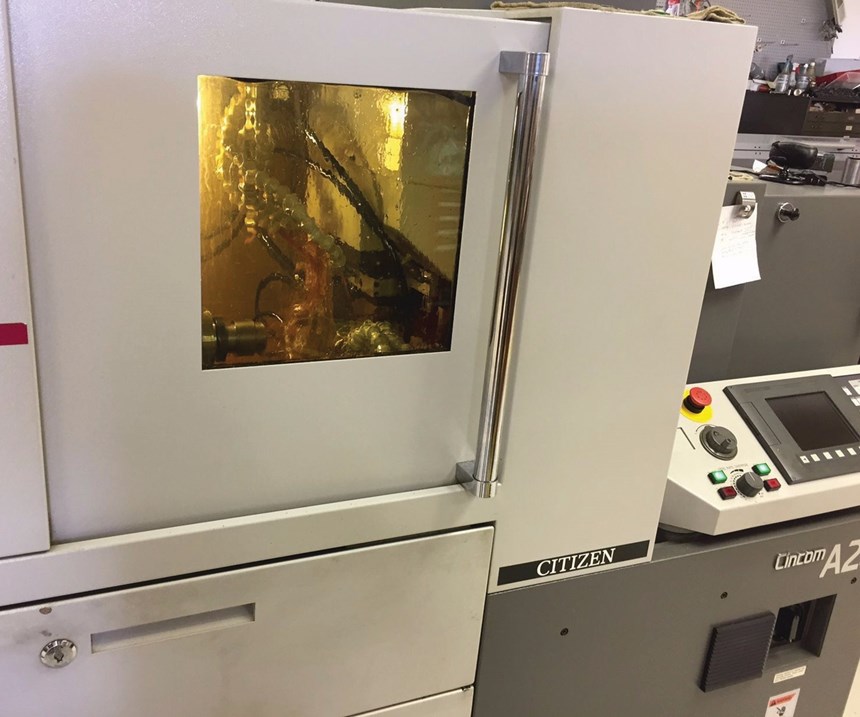Changing Cutting Tools Reduces Cycle Time by 7 Minutes in Hard-Turning Application
L.A.Y. Precision Machine’s cycle time to bore a hole in a bushing was more than eight minutes. Horn USA’s Supermini type-105 tool system with an HS36-grade boring bar insert reduced this cycle time.
Share




Small changes can result in big improvements, as Kyle Hawley, owner of L.A.Y. Precision Machine, discovered when he was trying to reduce the cycle time required to hard-turn an aerospace part his shop produces. By switching to a new boring bar from Horn USA Inc. (Franklin, Tennessee), L.A.Y. reduced the cycle time on the part by more than seven minutes.
L.A.Y. Precision Machine was founded in 1946 in Novi, Michigan. Mr. Hawley joined the contract CNC shop as a machinist in 2007, when it moved to West Branch, Michigan, and 10 years later, he and his wife bought it from the family that founded it. The company specializes in precision Swiss turning and machining of aerospace, military, medical and electrical parts. Production volumes range from 100 to 10,000 parts per year.
One such part is a bushing for a hydraulic pump used in the aerospace industry. The shop produces 2,000 of these bushings every year. They are made from 1-inch-diameter 8620 alloy steel barstock that is fed by an automatic bar feeder into a Swiss-style turning machine, where the inner and outer diameters are blanked. The workpieces are sent out for case-hardening to 60 HRC and returned for hard-turning operations. A 1.5-inch-deep hole is then bored into each piece, holding a tolerance of ±0.0005 inch.
Mr. Hawley recognized that the CCMT-type carbide cutting tool insert that the shop was using to bore the hole was causing three specific problems. He says that each corner only lasted for 10 or 15 parts, and the cycle time for each piece was more than eight minutes. He also was not satisfied with the 38-microinch-Ra surface finish that the cutting tool produced.
His cutting tool supplier put him in touch with an application and sales engineer at Horn, who recommended the Supermini 105 tool system with an HS36-grade boring bar insert. The inserts have a carbide substrate, a high-temperature-resistant coating and an adapted cutting-edge geometry specifically designed for hard turning materials ranging to 66 HRC, eliminating the need for cubic boron nitride.
According to Mr. Hawley, the results achieved with the new cutting tool exceeded his expectations. Cycle time was reduced from 8 minutes, 5 seconds to 1 minute, 23 seconds, and each boring bar now can be used for 75 parts. In addition, surface finish Ra improved to 20 microinches. Mr. Hawley says that the boring bar can be changed out quickly, which is an additional benefit. All of this adds up to a 78 percent reduction in manufacturing cost. “Considering we annually make 2,000 of these bushings, time and cost savings really add up,” Mr. Hawley says.
The shop has used the boring bar on other parts with similar effect, he says, including on an Inconel fuel nozzle. The previous cutting tool could machine 20 to 30 pieces, while the new boring bar yields more than 150 pieces.
Mr. Hawley plans to look for more simple improvements like this that his shop can make. “As we continue to upgrade equipment, we’ll be checking in with Horn to help us match the right cutting tools to the jobs. I like that I simply let them know the kind of material we’re working with, and they recommend cutting tool types, grades, and even speeds and feed rates,” he says.
Related Content
Ceratizit Product Update Enhances Cutting Tool Solutions
The company has updated its MaxiMill 273-08 face mill, WPC – Change Drill, as well as the HyPower Rough and HyPower Access 4.5-degree hydraulic chucks.
Read MoreCeratizit Offers Custom Boring Tool for Heavy Goods Vehicles
The boring tool roughs, chamfers and reams/fine finishes holes in a single operation.
Read MoreKennametal's Expanded Tooling Portfolio Improves Performance
The company has launch eight new products that expand on and support existing platforms across multiple applications.
Read MoreCustom PCD Tools Extend Shop’s Tool Life Upward of Ten Times
Adopting PCD tooling has extended FT Precision’s tool life from days to months — and the test drill is still going strong.
Read MoreRead Next
Setting Up the Building Blocks for a Digital Factory
Woodward Inc. spent over a year developing an API to connect machines to its digital factory. Caron Engineering’s MiConnect has cut most of this process while also granting the shop greater access to machine information.
Read MoreBuilding Out a Foundation for Student Machinists
Autodesk and Haas have teamed up to produce an introductory course for students that covers the basics of CAD, CAM and CNC while providing them with a portfolio part.
Read More5 Rules of Thumb for Buying CNC Machine Tools
Use these tips to carefully plan your machine tool purchases and to avoid regretting your decision later.
Read More.png;maxWidth=970;quality=90)






















.png;maxWidth=300;quality=90)















